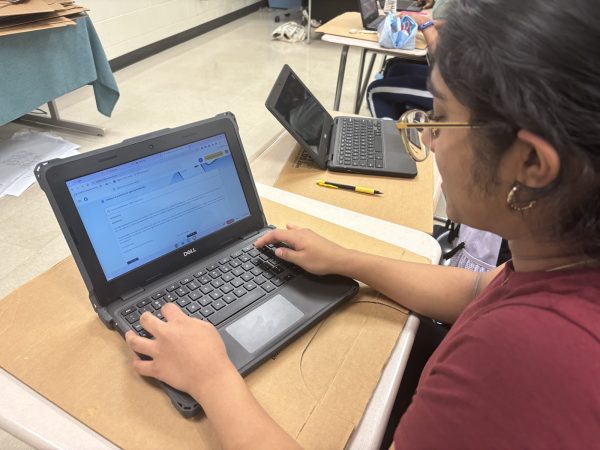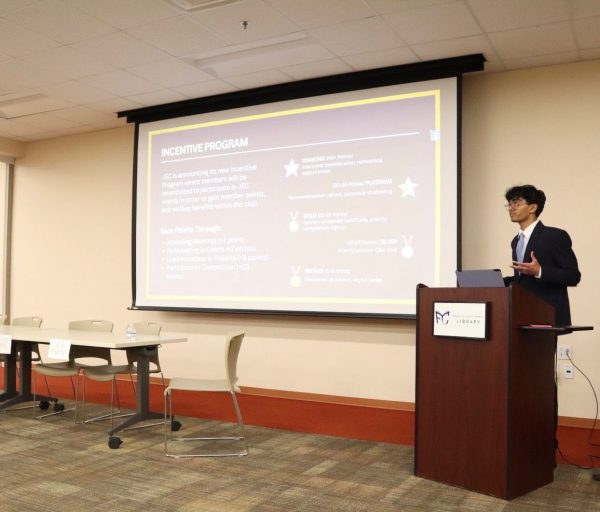Climate Change: A Public Health Issue That’s Not Too Late to Solve

Aryan Batada, the President of 350 Lambert, a climate change activism club, is seen leading a cleanup at Sims Lake Park. Taken by Richa Sharma, September 17th, 2022.
Climate change is a highly debated issue. Many scientists regard climate change as a public health issue, while others argue climate change is a hoax. However, it is evident that climate change is an issue because its impacts are visible in peoples’ health, especially low income families.
The recent increase in hurricanes, flooding and wildfires dislocates families, businesses and takes away homes from those who have spent their life building them. The disruption of food systems, the stark rise in zoonoses (diseases that are transmitted to humans from infected animals) and the spread of food and water-borne illnesses are just a few of the ways that climate change negatively impacts public health.
Thousands of communities around the country, which are often low-income or predominantly colored neighborhoods, already suffer from environmental dangers. They are forced to deal with these problems more frequently than the average American.
Recent Extremes
This summer in Europe, drought and excessive heat forced ancient artifacts that had been underwater to the surface, creating a stunning image of the continent’s dwindling rivers and reservoirs. Many people also passed away due to the effects of the heat.
Very recently, a third of Pakistan became submerged in floods due to excessive rain, while Puerto Rico, Cuba and the U.S. Eastern Seaboard were hit by a Category 1 hurricane that caused flooding, heavy winds and rain.
According to The Associated Press, the death toll rose to 30 on Saturday, Oct. 1, 2022, including 27 fatalities in Florida and three more in Cuba, where the storm made landfall last week before making its way to the former. The Associated Press said that while drowning caused the majority of fatalities, other causes included the storm’s aftermath.
“Flooding can lead to the spreading of waterborne diseases like cholera or Hepatitis A, damage of property, loss of livestock, and the destruction of crops,” AP Environmental Science teacher Ms. Potter said.
Diseases such as cholera, typhoid fever and other potentially fatal infectious illnesses are usually spread through the ingestion of food, drink or water that has been tainted by the feces or urine of people who are excreting the pathogen. Flooding only accelerates the spread of these illnesses among local populations.
Who is affected the most?
According to the Mercy Corps, people living in the world’s poorest nations, such as Haiti and Timor-Leste have little access to resources to deal with disasters. The 2.5 billion smallholder farmers, herders and fishermen who depend on the environment and natural resources for food and income are the most vulnerable.
The richest 10% of the world’s population were accountable for over half of the world’s emissions in 2015, according to a 2020 research from Oxfam and the Stockholm Environment Institute. The world’s poorest 50%, are responsible for just 7% of emissions and will bear the brunt of climate consequences despite having the least to do with their creation.
“Exposure to high levels of air pollution can lead to respiratory problems, heart disease, and lung cancer,” Potter says.
These respiratory problems can be managed if not eliminated by unifying action in communities.
Solutions We Must Welcome
Overall, it is in each and every person’s hands to make a difference in reducing carbon emissions and living sustainable lifestyles.
Coal, oil and gas are major sources of our country’s electricity and heat. Reduce your heating and cooling, use energy-efficient electric appliances like LED lights and dishwashers, wash your clothes in cold water and hang up your clothes to dry rather than using a dryer.
The majority of the cars and trucks on the road today burn either diesel or gasoline. Driving less and using a bike or walking will both improve your health and fitness and assist the environment.
Eating more fruits and vegetables, whole grains, legumes, nuts and seeds while consuming less meat and dairy can have a large positive influence on the environment.
Every stage of production, from the extraction of raw materials through the fabrication and delivery of commodities to market, contributes to carbon emissions. Buy fewer goods and recycle as much as you can to conserve the environment. Drive electric cars, use solar or wind power to support your house and lessen fossil fuel energy.
At Lambert
Lambert High School contributes to local recycling and even has a school garden to help combat climate change.
Recycling lowers energy use, which in turn lowers greenhouse gas emissions. There is less demand for new resources when recycled materials are used to create new items. By doing this, greenhouse gas emissions from mining or extracting new minerals are avoided.
Climate 350 at Lambert is a student-led activism club to help combat climate change. The club gathers all types of students in Lambert through protests and clean ups to brighten the quality of life for future generations.
Simply using public transportation like the bus or riding your bike to school makes a difference in the long run.
“We have to do whatever we can, because at the end of the day, it’s our Earth and our time,” 350 Lambert president Aryan Batada said. “It’s as simple as organizing local park clean ups, because all these small steps add up.”
Your donation will help support The Lambert Post, Lambert High Schools student-run newspaper! Your contribution will allow us to purchase equipment and cover website hosting costs.











